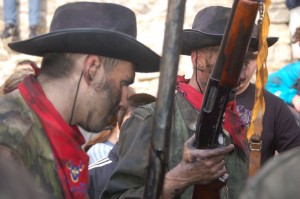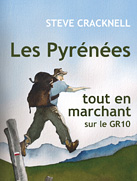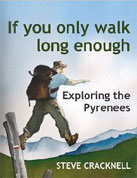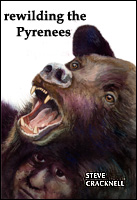The bear has seen her. It is only a few paces away and she is petrified, in both senses of the word. In any case she can’t run away – she is standing on the edge of a precipice. The bear scuttles towards her, rising to full height on its legs as it approaches. The girl screams wildly and puts her arms out in front of her. I have the fleeting – absurd – impression that they are going to dance. But the bear tackles her to the ground and they roll over, bumping down the slope at the edge of the precipice, arms and legs entangled. I hear a gunshot. For a second the bear and the girl stop moving. The bear looks around, nose balancing from side to side. Perhaps it has smelt something. Seeing me, it releases its grip and charges.
We are just outside the fortified town of Prats de Mollo. This is about as far south in France as you can get, near to the eastern end of the Pyrenees. There have been no bears here for decades but, in a mad parody of traditional bear hunting, once a year, in February, three bears are released to rampage as they see fit.
Half an hour previously I watched from the top of the castle wall as three men were dressed in sheepskins and daubed with a mixture of cooking oil and soot. When the signal was given, a group of hunters chased the ‘bears’ one by one out of the gate and down the hill towards the town a kilometre away. It is an event reminiscent of the bull-running in Pamplona, emphasising the importance of bears in Pyrenean culture.
If you are attacked by a bear, the experts say, there is no point in running away: a bear can run faster. Don’t climb a tree: bears are much better at it. The only thing to do is to make yourself as small as possible and play dead.
Even though this bear is not the real thing, I run away. I keep running, not looking back, hearing the bear’s footsteps as it crashes down the path behind me. I keep running. Ten, fifteen, twenty metres. I don’t understand why it hasn’t caught up with me, why I can’t feel its claws digging into my shoulders. But still, I don’t look back until I have caught up with my friends. Then I see that the bear has lost interest in me and has gone for another of our party. I glance back at the girl. She is getting up, a remarkably large tuft of fur in her right hand, covered in dust and with an enormous black oily smudge on her face and clothes, yet apparently intact.
One of the other bears tries to escape but hunters wielding sticks force it in the right direction. The bears, the hunters and the crowd which follows them are funnelled through the highest gate in the town’s walls. Once inside, there are more attacks and shrieks. The bears have a penchant for attractive young women but many other people end up with black smudges on their faces and clothes. One ageing man finds himself with a wonderfully precise black hand print on his bald scalp.
The air reeks of gunpowder and spilt red wine. Bombards and drums add to the chaos. Sometimes the crowd jumps violently, crushing onlookers already pressed hard back against the walls of the houses in the narrow cobbled streets. Every year there are injuries, sometimes broken bones, but the event continues to attract hundreds of spectators. Even today, with frost on the ground, the bears’ trajectory is lined with agitated participants half wishing to experience the bear’s hug – the victims acquire a special status in the eyes of the crowd – half hoping to avoid the inevitable rough and tumble.
By the end of the day the bears, bruised and exhausted, trailing blood and soot and oil, are channelled towards the market place outside the town’s east gate. The hunters with their guns and sticks are replaced by barbers with heavy chains, an axe, a basin, and, incongruously, a black pudding. By now the bears are very black, in contrast to the barbers, dressed in long white nightshirts and white caps, with arms, legs and faces flour-whitened. The bears are captured by the barbers. And then shaved with the black pudding.
As the last of the sheepskin ‘fur’ falls to the ground from this year’s bear-in-chief, a handsome, muscular young man is revealed: a well-known player from nearby Perpignan’s reputed rugby team. This must partly explain the young women’s willingness to be hugged and rolled on the ground, although this was not always the case. Brigitte Plo, now over 90 years old, looks back at the bear hunt when she was young: ‘Symbolically, it was the story of white and black, good and evil. The bear represented evil. He wanted to take a young woman back to his lair to deflower her. She prayed to the Virgin who sent the hunters to rescue her. That’s why, when I was young, when the bear caught a girl, the hunters had to fire in the air, so that she didn’t ‘fall’. That was an important point. At that time they didn’t plaster the girls with the oil and soot like now. Girls didn’t wear trousers, so we didn’t want to be made to fall over. It just wasn’t acceptable. That arrived later.’
‘Aren’t the girls afraid of getting hurt?’ I ask one of the villagers. ‘No,’ he says. ‘If you watch carefully, when the bear grabs them he always falls on his back so they are cushioned.’
It is then that I realise why the bear never caught me. Paradoxically, if I had run faster he would have caught up with me, but being relatively old, fragile, and wearing glasses saved me.
The Bear festival (Fête de l’Ours) takes place from Sunday 14 February to Tuesday 16 February 2010. The bear hunt starts at 3 pm at the Fort Lagarde above the town. The festival includes traditional carnivals, dances and a children’s version of the bear hunt.
The Fort Lagarde, the town defences and the underground tunnel which joins them were constructed by Vauban in the 17th century as part of Louis XIV’s defensive strategy. In the next valley to the north, two other Vauban forts, Villefranche de Conflent and Mont-Louis, have recently become World Heritage Sites.
Access: Perpignan airport (62 km, 1 hour) or Gerona airport, Spain (123km, 2 hours).
Website: http://www.pratsdemollolapreste.com/













Footprints on the mountains